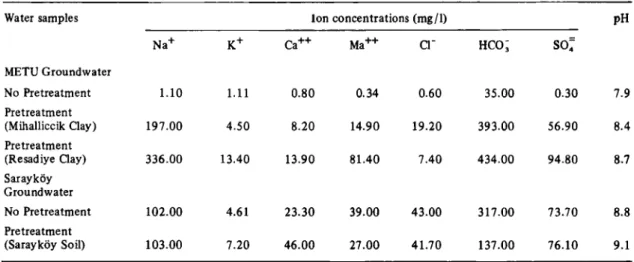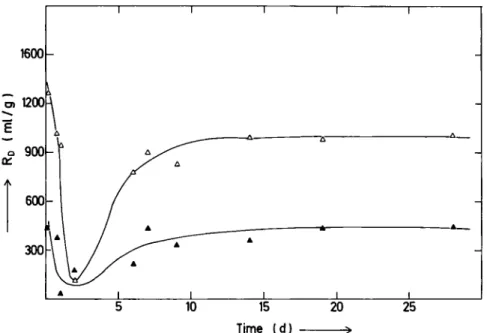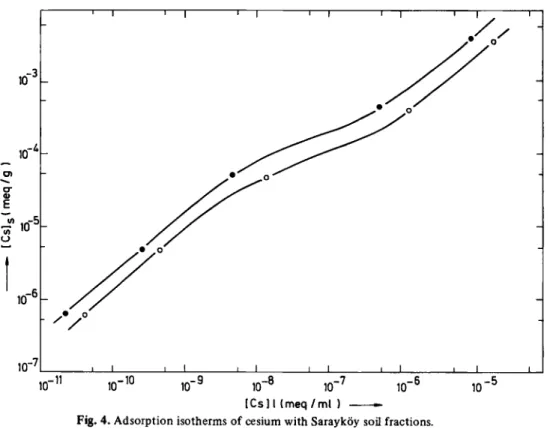Radiochimica Acta 44/45, 1 4 7 - 1 5 1 ( 1 9 8 8 )
© R. Oldenbourg Verlag, München 1 9 8 8 - 0 0 3 3 - 8 2 3 0 / 8 8 $ 3.00+0.00
Sorption of Cesium and Strontium on Montmorillonite and Kaolinite*
By H. N. E R T E N ^ S . AKSOYOGLU2, S. HATIPOGLU2 and H. GÖKTÜRK2, 1 Department of Chemistry, Bilkent University Ankara-Turkey
2 Department of Chemistry, Middle East Technical University, Ankara-Turkey (Received S e p t e m b e r 12, 1987; revised J a n u a r y 11, 1988)
Clays ¡Sorption I Fission products/Batch method / Distribution
ratios
Summary
Sorption characteristics of Cs+ and S r+ + on m o n t m o r i l l o n i t e and
kaolinite type clays and soil fractions f r o m various regions of T u r k e y were studied using the batch m e t h o d . 1 3 7C s and , 0S r
were used as tracers. Concentrations of Cs+ and S r+ + ions ranged
f r o m 1 0 " ' t o 1 0 "2 mol/1; natural g r o u n d w a t e r was used and the grain size of t h e solid particles was < 2 0 /am. Equilibrium was reached in 4 - 7 days for Cs+ and 7 - 1 1 days f o r S r+ +. The
distri-bution coefficient, RD, increased w i t h decreasing grain size, sug-gesting mainly a surface p h e n o m e n o n . T h e sorption isotherms were non-linear suggesting at least t w o d i f f e r e n t sorption proces-ses. T h e sorption was found to be p r e d o m i n a n t l y reversible. Cs+ was sorbed much stronger than S rT T in all samples.
Introduction
Storage of radioactive wastes in underground repositories
necessitates information on the mobility and chemical
behaviour of the individual radionuclides in geologic
en-vironments.
The fission products
1 3 7C s ( f
1 / 2= 3 0 . 2 y ) and
9 0S r
( t
1i 2 = 2 8 . 8 y ) , are the principle sources of radioactivity
during the first 1000 years, due t o their long half-lives
and high fission yields. They may be discharged into the
environment from nuclear power plants, nuclear weapon
tests and accidents occuring at reprocessing plants.
The interaction of Cs
+and Sr
2 +ions with various soil
fractions plays an important role in their dispersal to the
environment and thus in the extent of contamination of
underground waters. Of the various soil fractions, clays
are the most important components in such interactions.
The sorption properties of several radionuclides on
various sorbents has been the subject of many recent
in-vestigations [1—9].
In this work, the sorption characteristics of Cs
+and
S r
2 +on two types of clays and one soil fraction from
Turkey were studied, in line with plans t o establish a
radioactive waste treatment and storage facility.
Experimental
Kaolinite and montmorillonite type clays f r o m two
re-gions of Turkey (Mihaliccik and Resadiye) and soil
frac-tions from Sarayköy were used. Neutron activation
ana-lysis, Fourier Transform Infrared ( F T I R ) and X-Ray
Dif-fraction Spectrometry were used to elucidate the
struc-ture of the clay and soil fractions. Particles were separated
into various size fractions by a combination of wet
sieving followed by sedimentation using an Andreasen
pipette.
The sorption experiments were carried out using
groundwater from the Middle East Technical University
(METU) and Sarayköy Ground Water (SGW). The water
samples were filtered through 0.22 μτη Seitz
bacteriologi-cal filters before use. For the composition see Table 1.
Since
9 0S r and
1 3 7C s constitute the principle
radio-contaminants from relatively fresh spent uranium fuels,
Sr
2 +and Cs
+were first chosen for sorption studies. The
initial concentrations ranged from 10"
8to 10"
2mol/1.
1 3 7C s and
9 0S r were obtained f r o m the Radiochemical
Center, Amersham.
The sorption and desorption experiments were carried
out using the batch method. About 100 mg of clay or soil
samples were kept in contact with 10 ml of groundwater
in closed centrifuge tubes. They were shaken for four
days in the pretreatment step in order to equilibrate the
clay samples with the groundwater prior to the sorption
experiments. The phases were separated by centrifuging
at 6 0 0 0 rpm for 30 minutes. After addition of 10ml Cs
or Sr solution the samples were shaken again and
centri-fuged. The change of the adsórbate concentration in the
solution was determined radiochemically.
The distribution coefficient, R
D, was calculated f r o m :
=
í£li
=V-A°-A(V+AV)
D
[C], AW
swhere,
[ C ^ = Concentration of the cation in the solid phase
after sorption (mmol/g).
[ C ]
;= Concentration of the cation in the solution after
sorption ( m m o l / m l ) .
A o = Initial activity of the solution (cpm).
A = Activity of the solution after sorption (cpm).
V = Volume of solution added (ml).
A V = Volume of liquid remaining after pretreatment
and décantation (ml).
W = Mass of solid material (g).
For desorption studies 10 ml of groundwater was
added to the sample tube following the adsorption step,
shaken for seven days, centrifuged and decanted. The
activity of the liquid phase was then determined.
Similar expressions as above were used for the
calcu-lation of R
Dvalues for desorption studies. Correction
for the remaining activity f r o m the adsorption step was
* S u p p o r t e d in p a r t b y the International A t o m i c EnergyAgency Vienna, and by the Turkish A t o m i c Energy A u t h o r i t y , Ankara.
Water samples Ion concentrations (mg/1) P H N a+ K+ C a+ + M a+ + Q " HCO; s o ; METU G r o u n d w a t e r No Pretreatment 1.10 1.11 0 . 8 0 0.34 0.60 3 5 . 0 0 0.30 7.9 Pretreatment (Mihalliccik Clay) 1 9 7 . 0 0 4 . 5 0 8 . 2 0 14.90 19.20 3 9 3 . 0 0 5 6 . 9 0 8.4 Pre t r e a t m e n t (Resadiye Clay) 3 3 6 . 0 0 13.40 13.90 8 1 . 4 0 7 . 4 0 4 3 4 . 0 0 9 4 . 8 0 8.7 Sarayköy G r o u n d w a t e r No P r e t r e a t m e n t 1 0 2 . 0 0 4 . 6 1 2 3 . 3 0 3 9 . 0 0 4 3 . 0 0 3 1 7 . 0 0 7 3 . 7 0 8 . 8 Pre t r e a t m e n t (Sarayköy Soil) 1 0 3 . 0 0 7 . 2 0 4 6 . 0 0 2 7 . 0 0 4 1 . 7 0 1 3 7 . 0 0 7 6 . 1 0 9 . 1
made by determining the volume of liquid remaining
after adsorption and décantation. The experimental
proce-dure and the equations are described in more detail
else-where [10].
Results and discussion
Chemical analysis of water samples used in the
experi-ments as well as those resulting from pretreatment with
various clay and soil fractions, were carried out using
atomic absorption spectrometry. The results together
with pH values are given in Table 1. Since the radioactive
waste treatment and storage facility is planned to be
established in Ankara, using METU groundwater was
throught to be appropriate for sorption studies.
Further-more, since clay and soil samples were pretreated with
the groundwater prior to sorption, the compositions of
the different groundwaters after pretreatment are similar.
Neutron activation analysis was used for the
deter-mination of the concentrations of 13 elements in clay
samples from four different regions. Resadiye clay
(mont-morillonite) as well as Küre clay and Sindirgi clay (both
kaolinite) were found to contain considerable amounts of
Na, Ba and Fe. Detailed results are given in ref. 11.
FTIR-Spectrometry and X-ray diffraction studies
established the structure of the clay samples as kaolinite
(Mihaliccik Clay) and montmorillonite (Resadiye Clay)
types.
The principle constituents of Sarayköy soil fractions
were identified as quartz, calcite, halloysite arid chlorite.
The results of sorption kinetics is illustrated in Fig. 1
Time ( d ) »
Fig. 1. S o r p t i o n kinetics of cesium. Change of RD with c o n t a c t time f o r Mihalliccik Clay (Kaolinite).
• Particle size < 1 0 M m [ C s ] ° = 1.01 X 1 0 "5 m m o l / m l . A Particle size < 10 Mm [Cs]° = 1.19 X 1 0 " " m m o l / m l . O Particle size = 1 0 - 2 0 Μ Π Ι [CS]° = 1.01 X 1 0 "s m m o l / m l . Δ Particle size = 10-20ΜΠΙ [Cs]° = 1.19 X 1 0 " ' m m o l / m l .
Sorption of Cesium and Strontium on Montmorillonite and Kaolinite 149
5 10 15 20 25
Time (d) *
Fig. 2. Desorption kinetics of strontium. Change of RD with contact time, following adsorption, for
Rasadiye clay (Montmorillonite).
a Particle size < 10 Mm δ Particle size = 10 - 20μηι.
σι
^ 1000E
α
a:
< tio"
510"' IO"
3io"
210"
[ S r l
s(mmol/g) »
Fig. 3. The change of Rq values with strontium ion loading, for Rasadiye Clay (Montmorillonite). Particle
size = 1 0 ~ 2 0 μ π ι .
o Adsorption • Desorption.
for Cs. It is observed that steady state was reached in
about 4 ^ 7 days. Similar behaviour was observed for Sr,
however, the time to reach steady state was somewhat
longer, 7 - 1 1 days. Increase in R
Dwith decreasing particle
size suggest mainly a surface phenomenon.
The rate of adsorption was found to vary from 0.47
t o 9 . 9 0 m l / g h depending on the cation, its
concentra-tion, the particle size, the type of clay, pH of soluconcentra-tion,
and the speed of shaking. Other factors such as
solid/solu-tion (100 mg/ 10 ml) ratio and temperature (room
tem-perature) were the same in all experiments. In order to
study the effect of shaking, two different shaking machines
were used. A longitudinal shaking type with a shaking
frequency of 250 strokes/min, and a circular shaking
type with a speed of 150 rpm. No difference in the rate
of adsorption was observed. Smaller size particles ( < 10
μτη) did not show any change i n Ä
0values. In the case of
larger size particles ( 1 0 - 2 0 Mm), somewhat higher R
Dvalues were observed with the faster longitudinal shaker,
suggesting some degree of abrasion during shaking.
The desorption behaviour of Sr is illustrated in Fig. 2.
The figure suggests a rather complicated desorption
Fig. 4. Adsorption isotherms of cesium with Sarayköy soil fractions. • Particle size < 5 μπι
o Particle size = 5 - 1 0 Mm.
mechanism. Considerable initial rapid desorption seems
to be followed by a readsorption until steady stati is
reached. Similar behaviour was observed in the
desorp-tion of Cs.
The variation of the distribution ratio, R
D, as a
func-tion of Sr ion concentrafunc-tion in the solid phase is shown in
Fig. 3. It is seen that at lower Sr loadings ( < 1CT
2mmol
/g) the desorption was displaced to lower distribution
ratios, whereas at higher Sr loadings (.10"
1mmol/g) it is
displaced to higher R
Dvalues. However, the shape of the
adsorption curve was preserved in desorption. In the case
of Cs
+ion sorption on kaolinite the results for adsorption
and desorption were quite similar, indicating a reversible
sorption process. The shapes of the curves suggest the
existence of at least two types of adsorption and /or
ex-change mechanism. One type taking place at high ion
con-centrations and the other at low ion concon-centrations.
The sorption isotherms of Cs cation on Sarayköy soil
fractions are shown in Fig. 4. It is seen that the isotherms
are not linear. Similar behaviour was observed in the
sorp-tion of S r
2 +and Cs
+on the clay and soil fractions. The
sorption of Sr on Kaolinite clay was the only exception.
It gave a linear sorption isotherm, suggesting one type of
sorption mechanism. The Cs and Sr concentrations
present in the clay minerals and soil fractions at the
be-ginning of the sorption studies were estimated to be low
and were not taken into account.
Table 2 summarizes the steady state values of the
distribution coefficient,R
D, for different types of clay
and soil fractions used on this work. The high R
Dvalues
for soil fractions, particularly in the case of Cs sorption
is striking. This may be due to the presence of organic
components, such as humic acids, in the soil fractions.
Table 2. Steady state values of RQ for clay and soil fractions used in this work Solid material used Rd (ml/g) Sr
Cs
+ Mihalliccik Clay (Kaolinite) 120 2 0 0 0 Resadiye Clay (Montmorillonite) 1500 3500 Sarayköy Soil 4 0 0 27000Conclusions
The observed sorption behaviours of Sr and Cs on
mont-morillonite and kaolinite type clay minerals and on soil
fractions were found to be a function of the chemical
composition of these species, the water composition and
the properties of the solid sorbent. It was found that
generally montmorillonite clay adsorbs Cs and Sr much
more than kaolinite clay due to their different structural
characteristics.
The sorption isotherms are found to be mostly
non-linear. The distribution coefficients increased with
de-creasing grain size, suggesting mainly surface sorption.
The adsorption / desorption process was found to be
reversible for Cs sorption on clays, whereas Cs sorption
on Sarayköy soil and Sr sorption on clay and soil were
only partially reversible.
References
1. DLOUGHY, Α.: Movement of Radionuclides in the Aerated Zone, in Disposal of Radioactive Wastes into the Ground. IAEA, Vienna 1967, p. 241.
Sorption of Cesium and Strontium on Montmorillonite and Kaolinite 151
2. BRUGGENWERT, M. G. M., KAMPHORST, Α.: Survey of Experimental Information on Cation Exchange in Soil Sys-tems. In: Soil Chemistry (G. H. BOLT, ed.) Β. Physico-Chemical Models, Elsevier, Amsterdam 1979, p. 141. 3. PALMER, D. Α., SHIAO, S. Y., MEYER, R. E.,
WETHING-TON, J. Α.: Adsorption of Nuclides on Mixtures of Minerals, J. Inorg. Nucl. Chem. 43, 3317 (1981).
4. TORSTENFELT, B., ANDERSSON, K., ALLARD, B.: Sorp-tion of Strontium and Cesium on Rocks and Minerals, Chem. Geol. 36, 123 (1982).
5. BUNZL, K., SCHULTZ, W.: Distribution Coefficients of
1 3 7Cs and , sS r by Mixtures of Clay and Humic Material,
J. Radioanal. Nucl. Chem. 90, 23 (1985).
6. ALLARD, B., ITTNER, T., TORSTENFELT, B.: Migration of Trace Elements into Water-Exposed Natural Fissure Sur-faces of Granitic Rock, Chem. Geol. 49, 31 (1985). 7. TORSTENFELT, B.: Migration of the Fission Products
Strontium, Technetium, Iodine and Cesium in Clay, Radio-chim. Acta 39, 97 (1986).
8. GRÜTTER, Α., VON GUNTEN, H. R.: Sorption, Desorption und Austausch von Caesium an quartaren glaziofluvialen Schotterböden und Tonmineralien. PTB-SI-14, Proc. Chemie und Migrationsverhalten der Aktionoide und Spalt-produkte in natürlichen aquatischen Systemen. Herausg. J. I. KIM, E. WARNECKE, München 1987, p. 140. 9. GRÜTTER, Α., VON GUNTEN, H. R., RÖSSLER, E.:
Sorption, desorption and isotope exchange of Cesium ( 1 0 " ' - IO"3 M) on Chlorite, Clays Clay Miner. 34, 677
(1986).
10. ERTEN, H. N., AKSOYOGLU, S., GÖKTÜRK, H.: Sorption/Desorption of Cs on Clay and Soil Fractions from Various Regions of Turkey, 5th Symposium on Environmen-tal Radiochemical Analysis, 1 - 3 October 1986 Harwell, U. K., and Sci. Tot. Envir. 69, 269 (1988).
11. AKSOYOGLU, S., GÖKTÜRK, H„ ERTEN, H. N.: Neutron Activation Analysis of Turkish Clays, J. Radioanal. Nucl. Chem. Lett. 104, 97 (1986).


